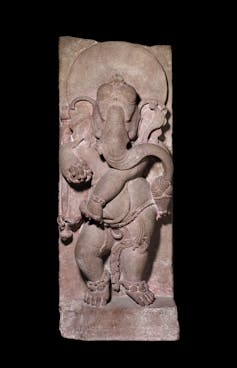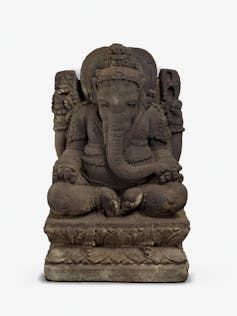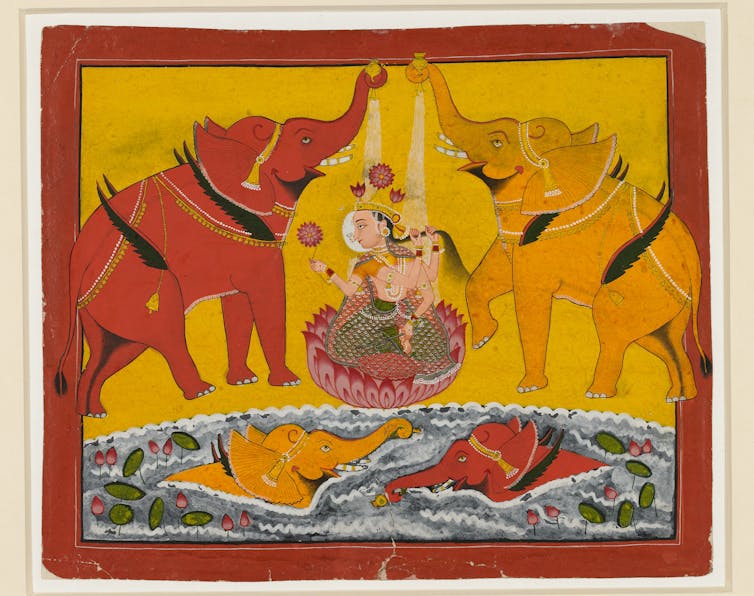British Museum Historical India, dwelling traditions The exhibition brings collectively exhibitions on the sacred artwork of Hinduism, Buddhism and Jainism. It additionally covers the unfold of those traditions’ devoted arts to different components of Asia.
The exhibition talks about spiritual id and relationships. Buddhism and Jainism distinguish between the huge surrounding traditions we collectively name Hinduism. Nevertheless, they’ve shut kinship with it in apply, beliefs and iconography. Museums that current sculptures alone don’t often attempt to inform about this difficult historical past.
All gadgets proven, those who return to 2,000 years in the past, should not purely of historic concern. There are expressions of traditions which are consistently dwelling in ways in which historic Egypt and classical European gods don’t.
Essentially the most immediately recognizable instance for guests of such dwelling historic traditions is probably going a statue of the elephant-headed god Ganesha. Guests will have the ability to see the uncommon and valuable 4th century sandstone Ganesha on the present. They’ll additionally see a small bronze model of historic Ganesha, just like the type of factor you discover in folks’s houses and a easy prayer is handled every morning.
The query of how one can respect sacred senses whereas nonetheless overlaying the exhibit is an ethical and aesthetic problem that museums (together with India) have little to deal with. It isn’t unusual to see such works being lined within the actuality of their continued apply and introduced on secular artwork shows. Nevertheless, right here the curators sought to create a relationship between the “sculptures” and “icons” of temples and homes.
Searching for one thing good? On Friday, you can get by way of the noise with a rigorously curated number of newest releases, reside occasions and exhibitions, straight into your inbox each two weeks. Join right here.
Lastly, there’s a want to contemplate the problematic historical past of the Imperial Museum and its previous. Many of the objects on show at this exhibition, in addition to the British Museum, are introduced extra broadly, and little acknowledge how they’ve come to be acquired.
The exhibition is working significantly to deal with most of those points.
It isn’t historic however not useless
The exhibition area is structured to respect the historic and up to date sensibilities of Buddhism and Jainism. That is signalled by refined adjustments in color and the association of translucent curtains, permitting for a transition between clear Jain, Buddhist and Hindu exhibitions.
On the identical time, the commonality between ideas and senses is conveyed strongly. The primary area focuses on the spirit of nature and respect for the demi, shared in all historic traditions. The air is stuffed with the sounds of South Asian birds and musical devices. The explanatory labels concentrate on, for instance, the permeation of iconographic options between traditions between Buddha and Jain lecturers, or the direct inclusion of the god of studying (Sarasvati) in each Hindu and Jain worship.

Councillor of the British Museum
The ultimate area can also be effectively introduced relating to the unfold of South Asian iconography into central, east and southeast Asia. It is a lengthy story that requires its personal narrative, however can solely be instructed by way of a fantastically chosen individual.
It’s using curators of the group advisory panel of individuals practising such traditions at present, giving data its sensitivity. The inclusion within the manufacturing of the exhibition will be seen with the outstanding mindfulness of the contents and symbols of those inert objects being alive and sacred to tons of of thousands and thousands of individuals.

Councillor of the British Museum
For instance, one Ganesha in Java from Indonesia attracts consideration to numerous components of his iconography. There’s a steady portrayal of him having damaged fangs throughout the continent (as Hindus know, he’s stated to have been damaged to jot down down the epic Mahabharata). Nevertheless, Ganesha additionally has a cranium. That is particular to the Javanese model. The label gently factors out that “numerous communities understood and worshiped him otherwise.”
The mix of group engagement and inventive shows not solely convey a way of respect for custom, but additionally elicit a respectful response from guests. Folks from inside custom ought to be happy with satisfaction with the outline of the image or icon. Folks from exterior the custom are invited to observe the exhibition with warning and care, like a cathedral.
I noticed a pair of younger Indian People watching fossilized ammonites from Nepal, thought of a symbolic illustration of God for worshippers of Vishnu. They livened it with what they’d in their very own diasporic house.
Elsewhere within the exhibition, an aged couple was caught standing up after silence in entrance of the drum slabs of the well-known first-century Amaravati Buddhist web site in South India. This slab was engraved simply earlier than the quickly gaining recognition of Buddha’s formation. Here’s a image related to him, however the Buddha himself is represented in an empty seat from the place he went.
How did you get right here?
One potential interpretation danger focuses on the continuity between previous objects and current actuality. Hindus at present might ask the place they sit in a easy historic story, from a social context that didn’t have the privilege of returning to sacred artwork. Extra broadly, there isn’t any recognition of the complexity of Hindu id and its formation throughout centuries throughout areas, social lessons, language, and theology.

Councillor of the British Museum
The weakest a part of the exhibition’s standard modern narrative is its timid approach of buying the British Museum’s questionable acquisition course of at an indirect degree. To say one thing has been “collected” by a serious basic, “whereas serving within the East India Firm Military,” hardly ever faces the query that the exhibition begins with a daring begin: “How did you come right here?”
The exhibition provides a strong visible story of the multi-existent traditions of historic India, that are sensitively outfitted to at present’s dwelling communities. Its immersive presentation is fascinating, and the tales it tells are respectful and modern.
The challenges of trustworthy self-expression and troublesome conversations about compensation stay. In its larger command, historic India, dwelling traditions are a step in the proper route. It’s the route that museums take care of context, responsiveness and involvement that they will not ignore.
Historical India, dwelling traditions Till October 19, 2025 on the British Museum in London

Get information straight in your inbox from actual specialists. Join our each day e-newsletter Obtain all the most recent protection of British information and analysis, from politics and enterprise to arts and science.


